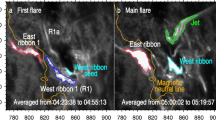Abstract
The spatial dynamics of microwave emission (data from the Nobeyama Radioheliograph) of active regions with a complex magnetic field configuration before powerful flares, as well as the fine structure of active sources of ultraviolet (UV) emission based on AIA/SDO data, are studied. It is shown that there is unsteady behavior of microwave sources, along with the ignition of a system of crossed UV loops (X-structures). A class-M X-ray flare occurs after several hours at the site of ignition of the intersecting UV loops. The similar behavior observed in microwave and ultraviolet emission in the five active regions studied by us likely serves as a sign of a preflare situation in the active region on the Sun.








Similar content being viewed by others
REFERENCES
Bakunina, I.A. and Melnikov, V.F., Dynamics of solar microwave emission before powerful flares in September 2017, Astron. Astrophys. Trans., 2019, vol. 31, vol. 31, no. 3, pp. 251–266.
Bakunina, I.A., Mel’nikov, V.F., and Morgachev, A.S., Preflare dynamics of microwave and ultraviolet emission in active regions of the Sun, Astrophysics, 2020, vol. 63, no. 2, pp. 252–259.
Borovik, V.N., Abramov-Maksimov, V.E., Tlatov, A.G., et al., Signs of preparation of powerful solar flares in September 2017 in microwave radiation and structure of the magnetic field of active region using RATAN-600 and SDO/HMI data, Izv. Krym. Astrofiz. Obs., 2018, vol. 114, no. 1, pp. 89–94.
Harra, L.K., Schrijver, C.J., Janvier, M., et al., The characteristics of solar X-class flares and CMEs: A paradigm for stellar superflares and eruptions?, Sol. Phys., 2016, vol. 291, pp. 1761–1782.
Ishkov, V.N., Emerging magnetic fluxes as a key to prediction of large solar flares, Izv. Ross. Akad. Nauk, Ser. Fiz., 1998, vol. 62, no. 9, pp. 1835–1839.
Podgorny, I.M. and Podgorny, A.I., Magnetic field distribution in the flare productive active region NOAA 10720, J. Atmos. Sol.-Terr. Phys., 2013, vol. 92, pp. 59–64.
Podgorny, A.I., Podgorny, I.M, and Meshalkina, N.S., Dynamics of magnetic fields of active regions in pre-flare states and during solar flares, Geomagn. Aeron. (Engl. Transl.), 2013, vol. 53, no. 6, pp. 795–805.
Schrijver, S., The nonpotentiality of coronae of solar active regions, the dynamics of the surface magnetic field, and the potential for large flares, Astrophys. J., 2016, vol. 820, id 103.
Severnyi, A.V., Study of the magnetic fields related to solar flares, Izv. Krym. Astron. Obs., 1960, vol. 22, pp. 12–40.
Severnyi, A.V., Nekotorye problemy fiziki Solntsa (Some Problems in Solar Physics), Moscow: Nauka, 1988.
Toriumi, S., Schrijver, C.J., Harra, L.K., et al., Magnetic properties of solar active regions that govern large solar flares and eruptions, Astrophys. J., 2017, vol. 834, id 56.
Verma, M., On the origin of two X-class flares in active region NOAA 12 673—shear flows and head-on collision of new and pre-existing flux, Astron. Astrophys., 2018, vol. 612, id A101.
ACKNOWLEDGMENTS
The work was carried out with data from the Nobeyama Radioheliograph, which operates with the assistance of the International Consortium for the Continued Operation of Nobeyama Radioheliograph (ICCON). ICCON includes the ISEE/Nagoya University, the National Astronomical Observatory of China, the Korea Astronomy and Science Institute, the National Institute of Communications and Technology, and the Goddard Space Flight Center of NASA. We are grateful to the SDO team for the observational data from AIA and HMI. A flare catalog is available at the Space Weather Prediction Center of NOAA.
Funding
The work was carried out with the partial support of the Russian Foundation for Basic Research (projects no. 18-02-00856, 17-52-80064) and the Basic Research Program of the Russian Academy of Sciences 12 “Issues of the Origin and Evolution of the Universe.”
Author information
Authors and Affiliations
Corresponding author
Ethics declarations
The authors declare that they have no conflict of interest.
Rights and permissions
About this article
Cite this article
Bakunina, I.A., Melnikov, V.F. & Morgachev, A.S. Signs of Preflare Situation in Solar Ultraviolet and Microwave Emission. Geomagn. Aeron. 60, 853–859 (2020). https://doi.org/10.1134/S001679322007004X
Received:
Revised:
Accepted:
Published:
Issue Date:
DOI: https://doi.org/10.1134/S001679322007004X



